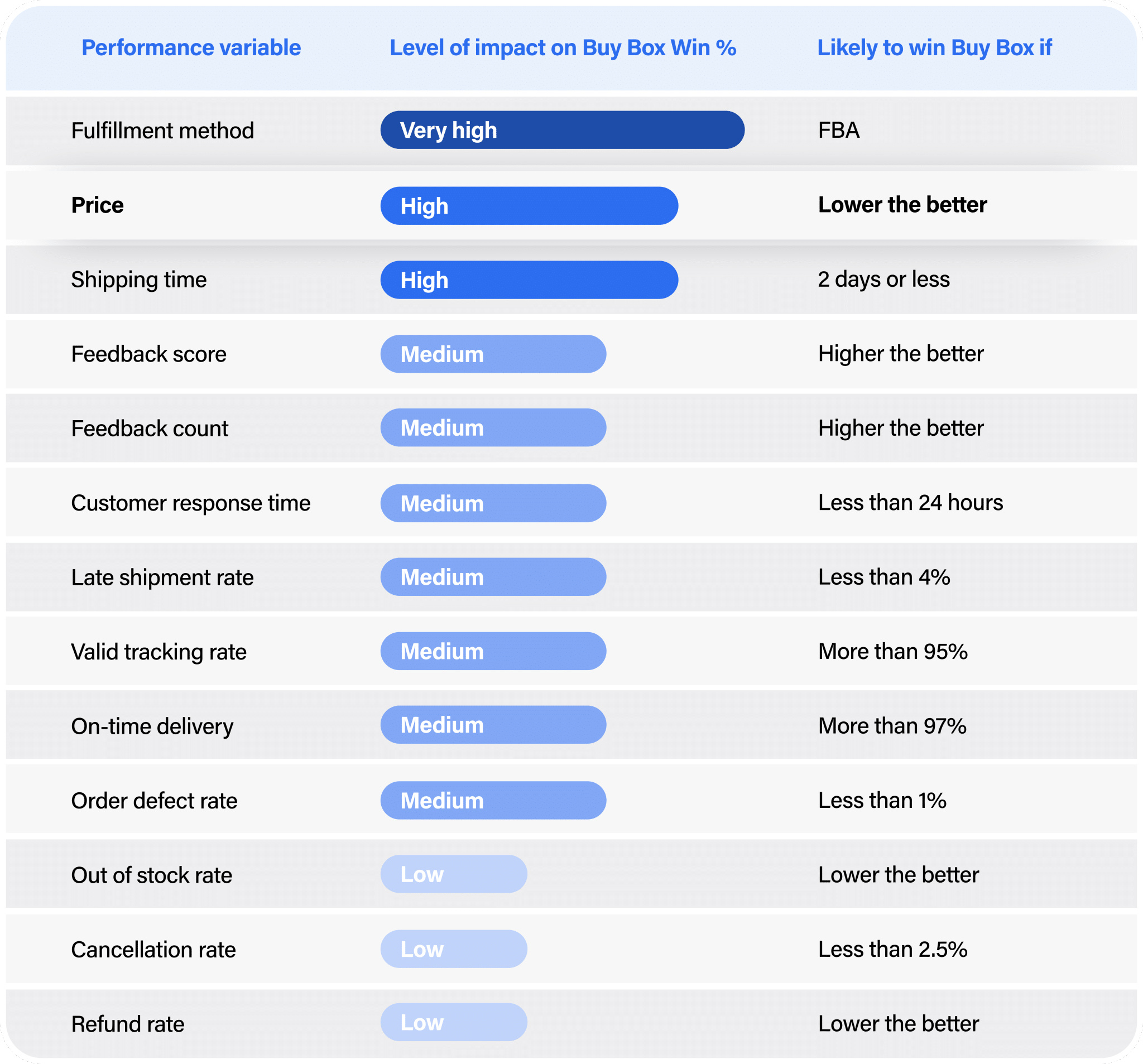13 Essential Factors for Winning the Amazon Buy Box
With approximately 83% of Amazon sales going to the Box winner, it's crucial for sellers to understand the mechanics of the Buy Box and strategize to secure a portion of it.

1. Fulfilment method
Fulfillment stands out as the foremost crucial factor evaluated by Amazon.
Now, fulfillment can be accomplished through three avenues: FBA (Fulfillment by Amazon), FBM (Fulfillment by Merchant), or Seller-Fulfilled Prime (SFP).
Amazon awards FBA a flawless rating across various metrics, encompassing shipping method, on-time delivery, and inventory depth. Consequently, it becomes highly improbable for merchants to beat FBA sellers.
2. Price
Pricing plays a critical role in winning the Buy Box.
A common misconception is that sellers with the lowest price automatically secure the Buy Box. While offering a lower price can indeed enhance your chances of winning a portion of the Buy Box, it’s just one among several criteria, albeit a significant one.
If your seller performance surpasses that of your competitors for a particular product, you may have the flexibility to increase your price and still maintain your share of the Buy Box.
Repricer helps you to instantly react to competitors’ price changes around the clock, boosting your chances of winning more Buy Boxes and consequently driving sales growth.
3. Shipping time
Amazon’s algorithm heavily favours sellers with fast shipping times when determining who wins the Buy Box.
Shipping time is categorized into the following brackets, limited to working days: 0-2 days, 3-7 days, 8-13 days, 14 or more days.
4. Feedback score
A high feedback score indicates to Amazon and potential buyers that a seller has a history of providing excellent service and satisfying customers.
A high feedback score positively contributes to overall seller performance, increasing the likelihood of winning the Buy Box.
5. Feedback count
Feedback count alone may not be as influential as feedback score, however it still carries considerable weight.
While individual feedback is important, a higher overall feedback count reflects consistent customer satisfaction over a longer period, which is favourable for Buy Box consideration.
6. Customer response time
Amazon evaluates sellers’ response times for the past seven, 30, and 90 days, comparing them with those of competing sellers. It’s believed that responding to customers within 12 hours enhances the likelihood of winning the Buy Box.
If over 10% of messages are replied to after 24 hours or remain unanswered, it may negatively impact ratings. However, sellers can mitigate this by marking messages as “no response needed,” thus avoiding negative repercussions.
7. Late shipment rate
Amazon prioritizes sellers with low late shipment rates (less than 4%) to secure the Buy Box, ensuring timely order fulfillment and a positive shopping experience for customers.
Consequently, sellers with lower late shipment rates stand a higher chance of winning the Buy Box. However, exceeding the 4% threshold may render sellers ineligible for the Buy Box.
8. Valid tracking rate
Offering a high valid tracking rate (over 95%) rate indicates to Amazon that a seller consistently provides accurate tracking information for their shipped orders.
As Amazon considers these sellers more dependable and trustworthy in fulfilling orders, it pushes them up the rank to be Buy Box eligible.
9. On-time delivery
Maintaining a high level of on-time delivery demonstrates reliability and customer commitment, crucial factors in ensuring positive shopping experiences.
Amazon prioritizes sellers for the Buy Box with a track record of consistently meeting or exceeding delivery expectations where 97% of orders must be delivered on time.
10. Order defect rate
Maintaining a low order defect rate is imperative as it reflects the quality of products and service provided by the seller.
This metric encompasses various factors such as negative feedback, A-to-z Guarantee claims, and chargebacks.
The Order Defect Rate (ODR) should remain below 1% for a seller to be Buy Box eligible. If this threshold is exceeded, penalties can be imposed on sellers.
11. Out of stock rate
This metric gauges how often a seller’s products become unavailable for purchase due to stock depletion. Amazon places importance on sellers with a low out-of-stock rate, as it signifies their proficiency in inventory management and meeting customer demand.
Sellers who can consistently maintain a low out-of-stock rate stand a better chance of winning the Buy Box, as Amazon values their reliability in delivering products promptly.
12. Cancellation rate
This metric measures the frequency with which a seller cancels orders after they have been placed by customers.
Having a cancellation rate below 2.5% creates a greater opportunity for sellers to win the Buy Box, as Amazon values their commitment to customer satisfaction and service excellence.
13. Refund rate
The refund rate measures how often customers request refunds for purchases from a specific seller. A lower refund rate indicates better performance, enabling Amazon to determine a seller’s eligibility for the Buy Box.